Strategic Management Report: Lidl's Global Expansion Strategy
VerifiedAdded on 2023/01/19
|14
|4793
|30
Report
AI Summary
This report provides a comprehensive strategic management analysis of Lidl, a global discount supermarket chain. It begins with an executive summary and introduction, followed by an analysis of external macro-environmental factors using PESTEL, examining political, economic, social, technological, environmental, and legal factors impacting Lidl's operations. Micro factors are analyzed using Porter's Five Forces to assess the competitive landscape, including the threat of new entrants, bargaining power of suppliers and buyers, the threat of substitutes, and industry competition. Internal factors are evaluated using the VRIO framework to identify valuable, rare, inimitable, and organizationally supported resources and capabilities. The report then identifies competitive strategies and strategic directions, culminating in a conclusion and references. The report aims to assess Lidl's current strategic position and provide recommendations for gaining a competitive edge, particularly in the context of global expansion and market competition.
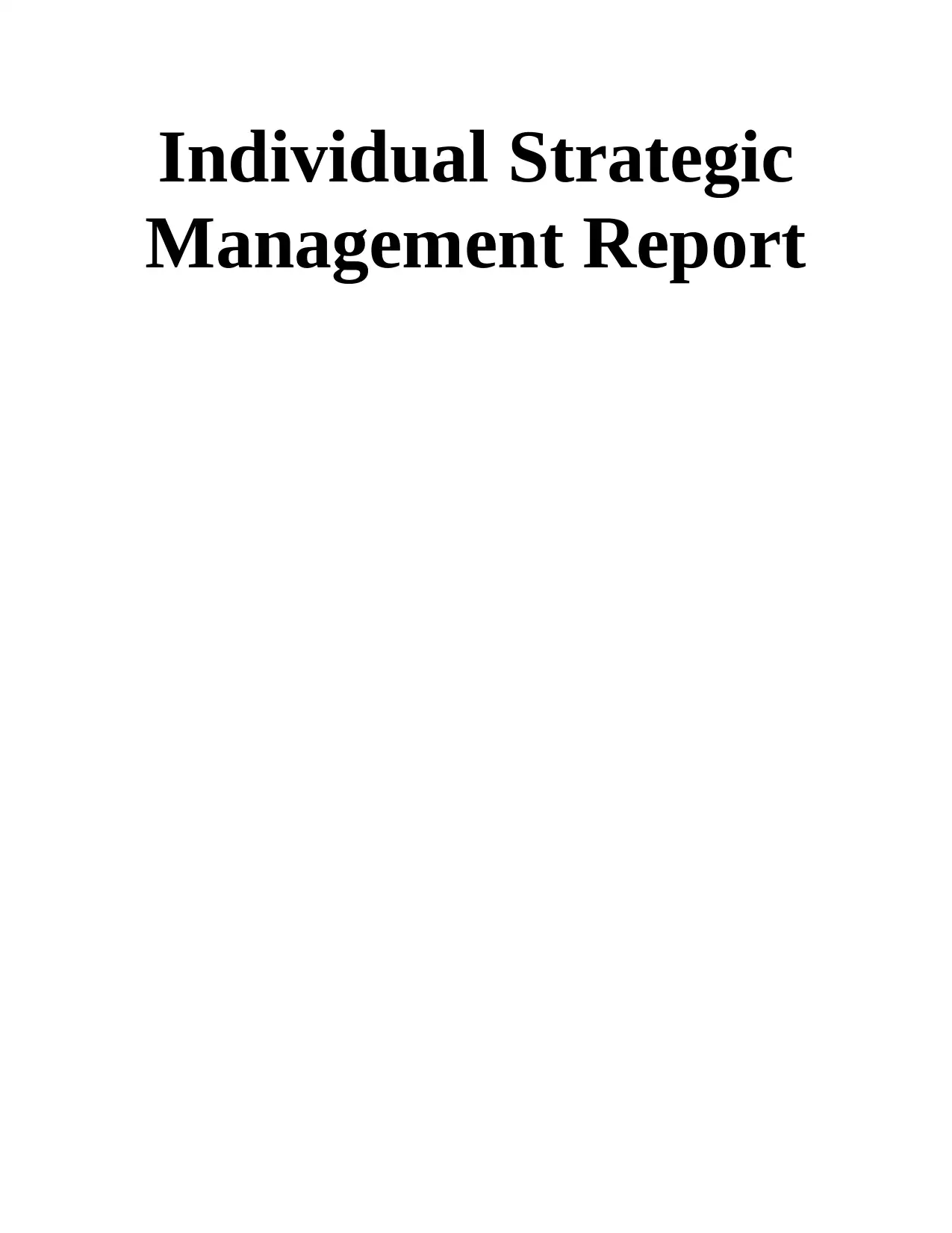
Individual Strategic
Management Report
Management Report
Paraphrase This Document
Need a fresh take? Get an instant paraphrase of this document with our AI Paraphraser
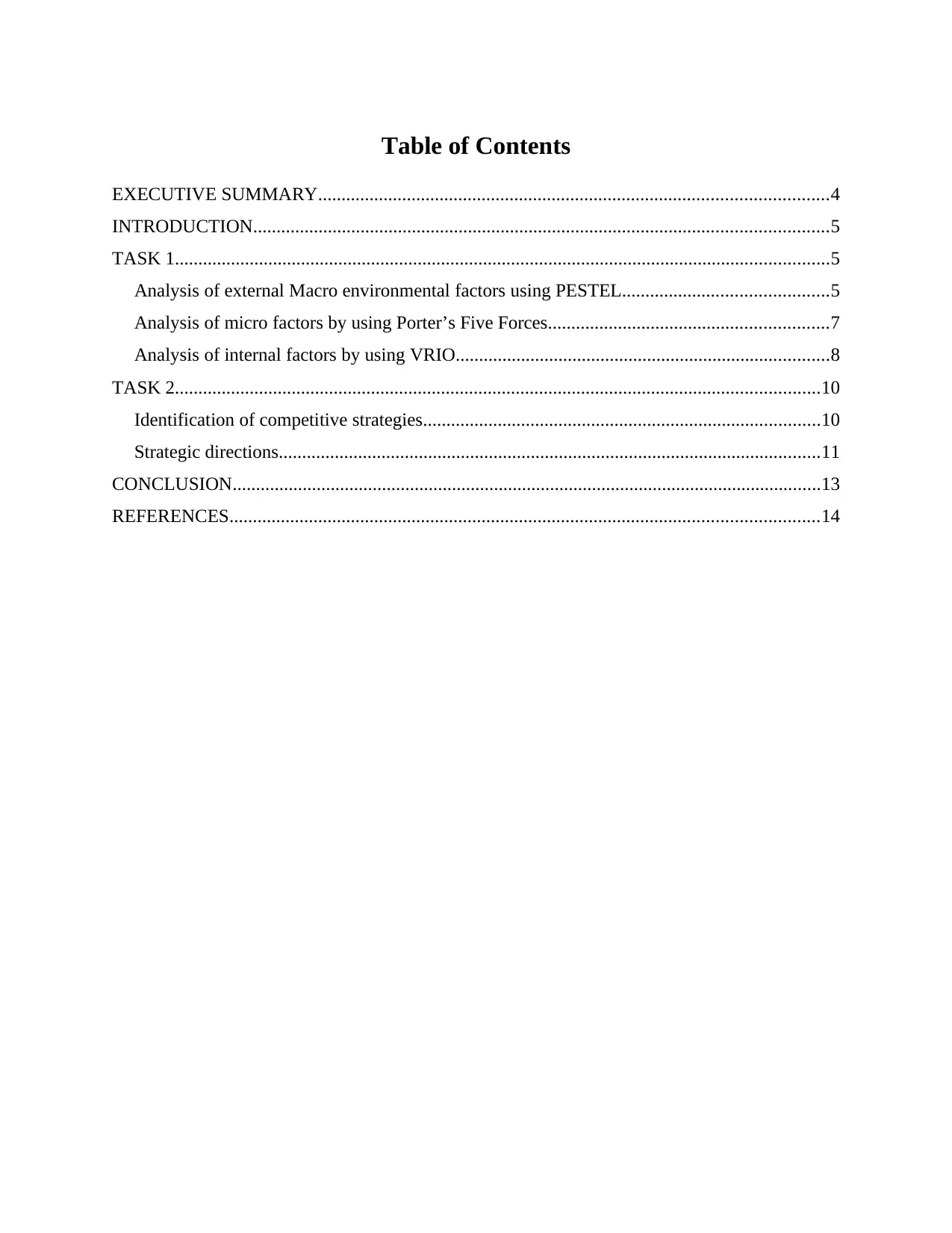
Table of Contents
EXECUTIVE SUMMARY.............................................................................................................4
INTRODUCTION...........................................................................................................................5
TASK 1............................................................................................................................................5
Analysis of external Macro environmental factors using PESTEL............................................5
Analysis of micro factors by using Porter’s Five Forces............................................................7
Analysis of internal factors by using VRIO................................................................................8
TASK 2..........................................................................................................................................10
Identification of competitive strategies.....................................................................................10
Strategic directions....................................................................................................................11
CONCLUSION..............................................................................................................................13
REFERENCES..............................................................................................................................14
EXECUTIVE SUMMARY.............................................................................................................4
INTRODUCTION...........................................................................................................................5
TASK 1............................................................................................................................................5
Analysis of external Macro environmental factors using PESTEL............................................5
Analysis of micro factors by using Porter’s Five Forces............................................................7
Analysis of internal factors by using VRIO................................................................................8
TASK 2..........................................................................................................................................10
Identification of competitive strategies.....................................................................................10
Strategic directions....................................................................................................................11
CONCLUSION..............................................................................................................................13
REFERENCES..............................................................................................................................14
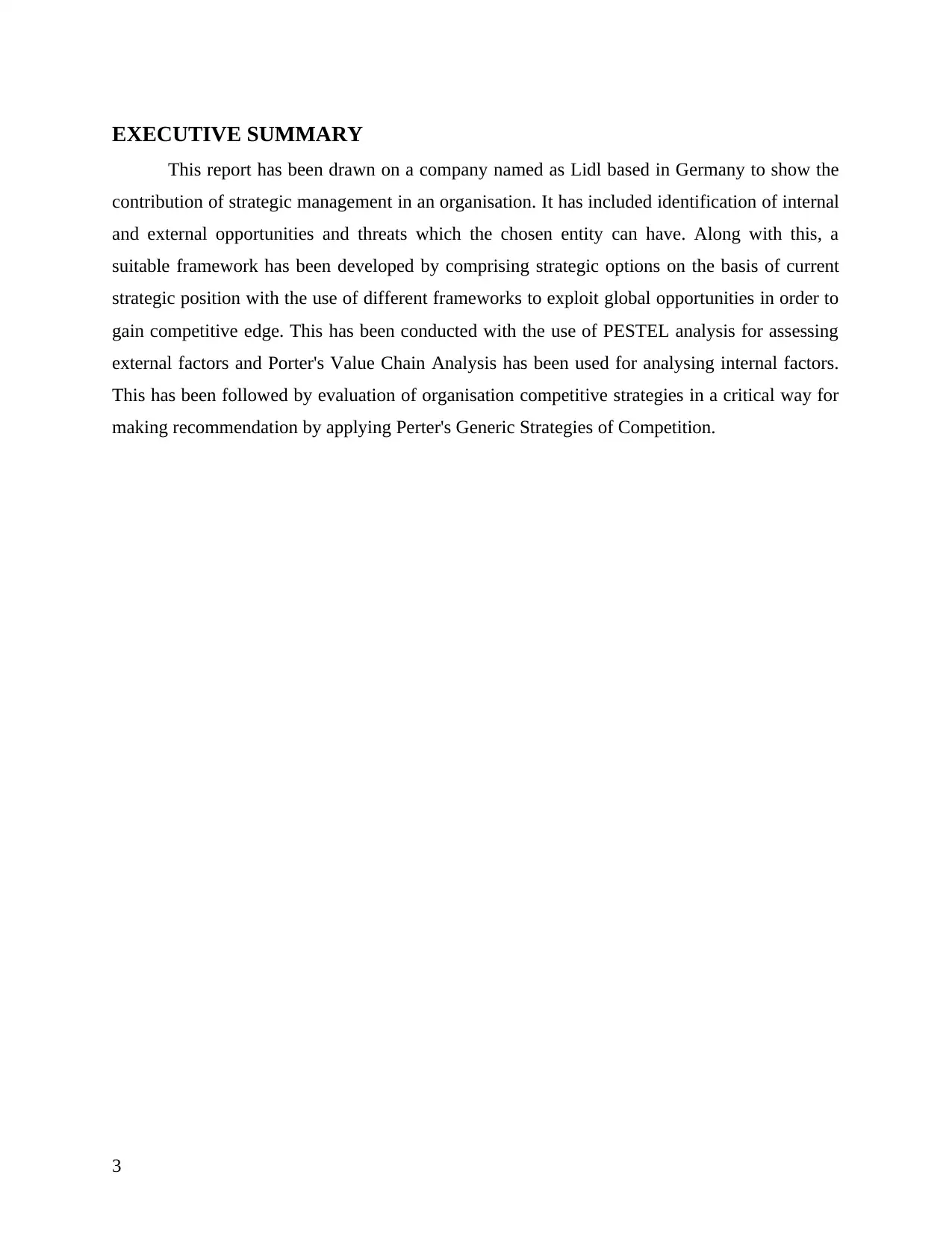
EXECUTIVE SUMMARY
This report has been drawn on a company named as Lidl based in Germany to show the
contribution of strategic management in an organisation. It has included identification of internal
and external opportunities and threats which the chosen entity can have. Along with this, a
suitable framework has been developed by comprising strategic options on the basis of current
strategic position with the use of different frameworks to exploit global opportunities in order to
gain competitive edge. This has been conducted with the use of PESTEL analysis for assessing
external factors and Porter's Value Chain Analysis has been used for analysing internal factors.
This has been followed by evaluation of organisation competitive strategies in a critical way for
making recommendation by applying Perter's Generic Strategies of Competition.
3
This report has been drawn on a company named as Lidl based in Germany to show the
contribution of strategic management in an organisation. It has included identification of internal
and external opportunities and threats which the chosen entity can have. Along with this, a
suitable framework has been developed by comprising strategic options on the basis of current
strategic position with the use of different frameworks to exploit global opportunities in order to
gain competitive edge. This has been conducted with the use of PESTEL analysis for assessing
external factors and Porter's Value Chain Analysis has been used for analysing internal factors.
This has been followed by evaluation of organisation competitive strategies in a critical way for
making recommendation by applying Perter's Generic Strategies of Competition.
3
⊘ This is a preview!⊘
Do you want full access?
Subscribe today to unlock all pages.

Trusted by 1+ million students worldwide
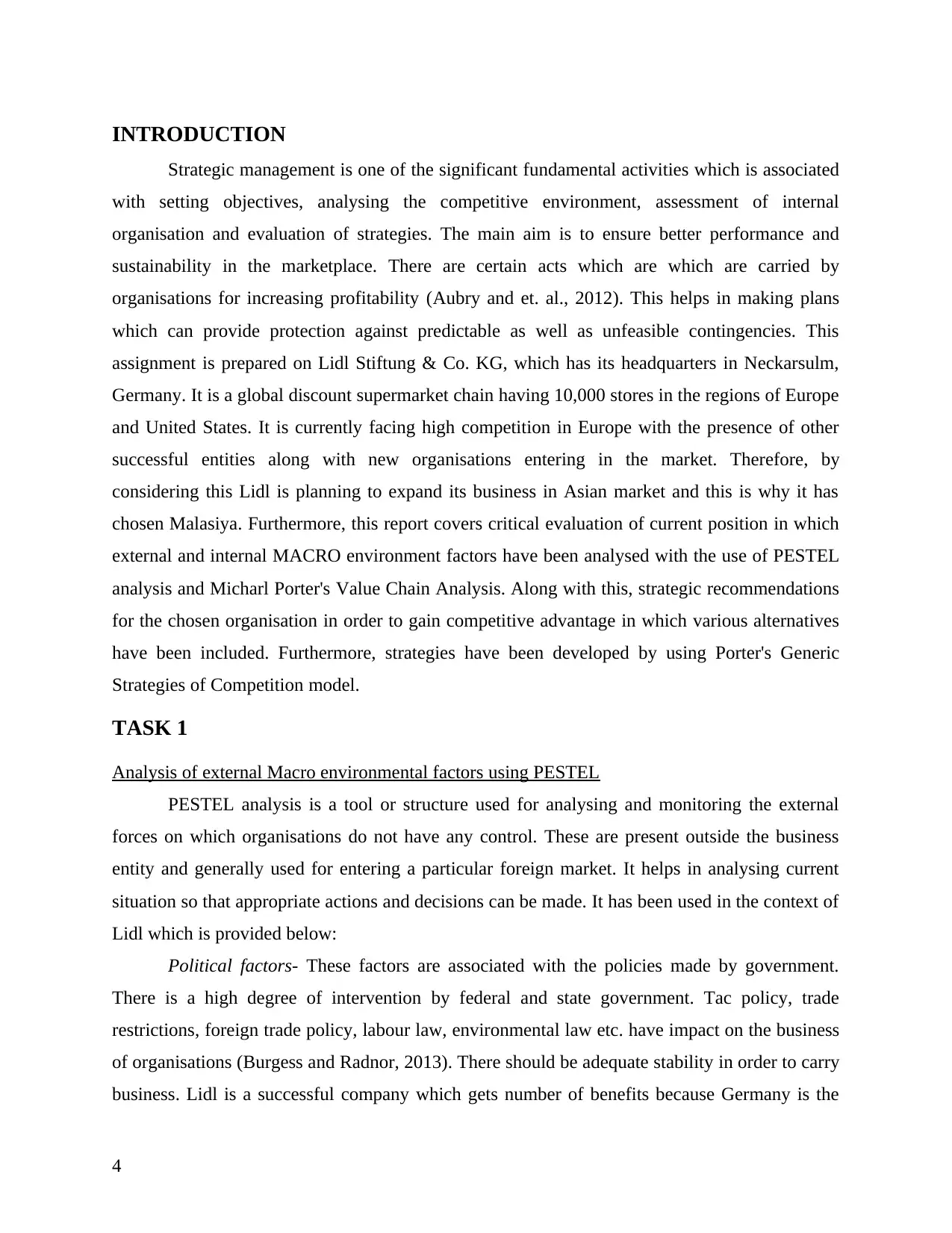
INTRODUCTION
Strategic management is one of the significant fundamental activities which is associated
with setting objectives, analysing the competitive environment, assessment of internal
organisation and evaluation of strategies. The main aim is to ensure better performance and
sustainability in the marketplace. There are certain acts which are which are carried by
organisations for increasing profitability (Aubry and et. al., 2012). This helps in making plans
which can provide protection against predictable as well as unfeasible contingencies. This
assignment is prepared on Lidl Stiftung & Co. KG, which has its headquarters in Neckarsulm,
Germany. It is a global discount supermarket chain having 10,000 stores in the regions of Europe
and United States. It is currently facing high competition in Europe with the presence of other
successful entities along with new organisations entering in the market. Therefore, by
considering this Lidl is planning to expand its business in Asian market and this is why it has
chosen Malasiya. Furthermore, this report covers critical evaluation of current position in which
external and internal MACRO environment factors have been analysed with the use of PESTEL
analysis and Micharl Porter's Value Chain Analysis. Along with this, strategic recommendations
for the chosen organisation in order to gain competitive advantage in which various alternatives
have been included. Furthermore, strategies have been developed by using Porter's Generic
Strategies of Competition model.
TASK 1
Analysis of external Macro environmental factors using PESTEL
PESTEL analysis is a tool or structure used for analysing and monitoring the external
forces on which organisations do not have any control. These are present outside the business
entity and generally used for entering a particular foreign market. It helps in analysing current
situation so that appropriate actions and decisions can be made. It has been used in the context of
Lidl which is provided below:
Political factors- These factors are associated with the policies made by government.
There is a high degree of intervention by federal and state government. Tac policy, trade
restrictions, foreign trade policy, labour law, environmental law etc. have impact on the business
of organisations (Burgess and Radnor, 2013). There should be adequate stability in order to carry
business. Lidl is a successful company which gets number of benefits because Germany is the
4
Strategic management is one of the significant fundamental activities which is associated
with setting objectives, analysing the competitive environment, assessment of internal
organisation and evaluation of strategies. The main aim is to ensure better performance and
sustainability in the marketplace. There are certain acts which are which are carried by
organisations for increasing profitability (Aubry and et. al., 2012). This helps in making plans
which can provide protection against predictable as well as unfeasible contingencies. This
assignment is prepared on Lidl Stiftung & Co. KG, which has its headquarters in Neckarsulm,
Germany. It is a global discount supermarket chain having 10,000 stores in the regions of Europe
and United States. It is currently facing high competition in Europe with the presence of other
successful entities along with new organisations entering in the market. Therefore, by
considering this Lidl is planning to expand its business in Asian market and this is why it has
chosen Malasiya. Furthermore, this report covers critical evaluation of current position in which
external and internal MACRO environment factors have been analysed with the use of PESTEL
analysis and Micharl Porter's Value Chain Analysis. Along with this, strategic recommendations
for the chosen organisation in order to gain competitive advantage in which various alternatives
have been included. Furthermore, strategies have been developed by using Porter's Generic
Strategies of Competition model.
TASK 1
Analysis of external Macro environmental factors using PESTEL
PESTEL analysis is a tool or structure used for analysing and monitoring the external
forces on which organisations do not have any control. These are present outside the business
entity and generally used for entering a particular foreign market. It helps in analysing current
situation so that appropriate actions and decisions can be made. It has been used in the context of
Lidl which is provided below:
Political factors- These factors are associated with the policies made by government.
There is a high degree of intervention by federal and state government. Tac policy, trade
restrictions, foreign trade policy, labour law, environmental law etc. have impact on the business
of organisations (Burgess and Radnor, 2013). There should be adequate stability in order to carry
business. Lidl is a successful company which gets number of benefits because Germany is the
4
Paraphrase This Document
Need a fresh take? Get an instant paraphrase of this document with our AI Paraphraser
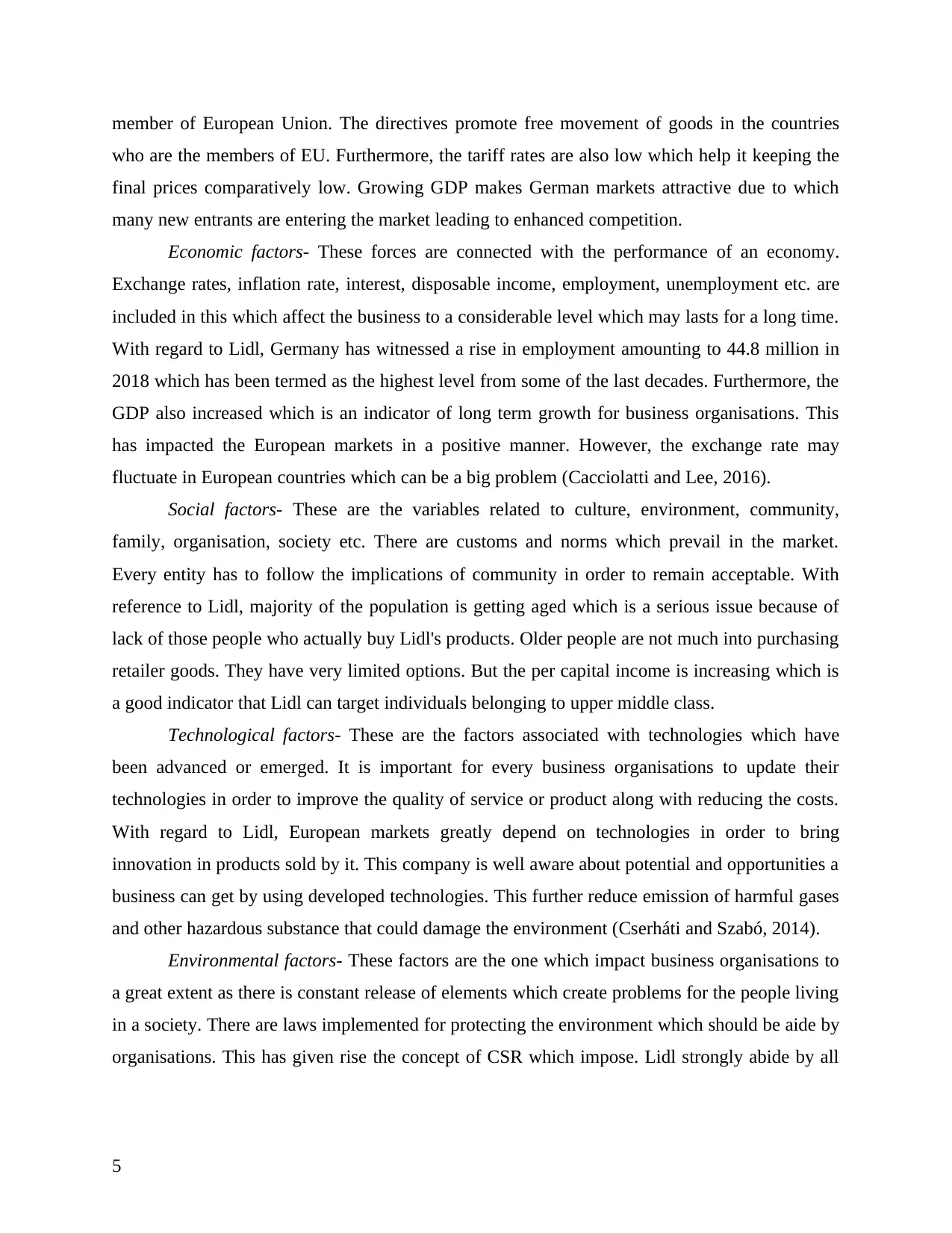
member of European Union. The directives promote free movement of goods in the countries
who are the members of EU. Furthermore, the tariff rates are also low which help it keeping the
final prices comparatively low. Growing GDP makes German markets attractive due to which
many new entrants are entering the market leading to enhanced competition.
Economic factors- These forces are connected with the performance of an economy.
Exchange rates, inflation rate, interest, disposable income, employment, unemployment etc. are
included in this which affect the business to a considerable level which may lasts for a long time.
With regard to Lidl, Germany has witnessed a rise in employment amounting to 44.8 million in
2018 which has been termed as the highest level from some of the last decades. Furthermore, the
GDP also increased which is an indicator of long term growth for business organisations. This
has impacted the European markets in a positive manner. However, the exchange rate may
fluctuate in European countries which can be a big problem (Cacciolatti and Lee, 2016).
Social factors- These are the variables related to culture, environment, community,
family, organisation, society etc. There are customs and norms which prevail in the market.
Every entity has to follow the implications of community in order to remain acceptable. With
reference to Lidl, majority of the population is getting aged which is a serious issue because of
lack of those people who actually buy Lidl's products. Older people are not much into purchasing
retailer goods. They have very limited options. But the per capital income is increasing which is
a good indicator that Lidl can target individuals belonging to upper middle class.
Technological factors- These are the factors associated with technologies which have
been advanced or emerged. It is important for every business organisations to update their
technologies in order to improve the quality of service or product along with reducing the costs.
With regard to Lidl, European markets greatly depend on technologies in order to bring
innovation in products sold by it. This company is well aware about potential and opportunities a
business can get by using developed technologies. This further reduce emission of harmful gases
and other hazardous substance that could damage the environment (Cserháti and Szabó, 2014).
Environmental factors- These factors are the one which impact business organisations to
a great extent as there is constant release of elements which create problems for the people living
in a society. There are laws implemented for protecting the environment which should be aide by
organisations. This has given rise the concept of CSR which impose. Lidl strongly abide by all
5
who are the members of EU. Furthermore, the tariff rates are also low which help it keeping the
final prices comparatively low. Growing GDP makes German markets attractive due to which
many new entrants are entering the market leading to enhanced competition.
Economic factors- These forces are connected with the performance of an economy.
Exchange rates, inflation rate, interest, disposable income, employment, unemployment etc. are
included in this which affect the business to a considerable level which may lasts for a long time.
With regard to Lidl, Germany has witnessed a rise in employment amounting to 44.8 million in
2018 which has been termed as the highest level from some of the last decades. Furthermore, the
GDP also increased which is an indicator of long term growth for business organisations. This
has impacted the European markets in a positive manner. However, the exchange rate may
fluctuate in European countries which can be a big problem (Cacciolatti and Lee, 2016).
Social factors- These are the variables related to culture, environment, community,
family, organisation, society etc. There are customs and norms which prevail in the market.
Every entity has to follow the implications of community in order to remain acceptable. With
reference to Lidl, majority of the population is getting aged which is a serious issue because of
lack of those people who actually buy Lidl's products. Older people are not much into purchasing
retailer goods. They have very limited options. But the per capital income is increasing which is
a good indicator that Lidl can target individuals belonging to upper middle class.
Technological factors- These are the factors associated with technologies which have
been advanced or emerged. It is important for every business organisations to update their
technologies in order to improve the quality of service or product along with reducing the costs.
With regard to Lidl, European markets greatly depend on technologies in order to bring
innovation in products sold by it. This company is well aware about potential and opportunities a
business can get by using developed technologies. This further reduce emission of harmful gases
and other hazardous substance that could damage the environment (Cserháti and Szabó, 2014).
Environmental factors- These factors are the one which impact business organisations to
a great extent as there is constant release of elements which create problems for the people living
in a society. There are laws implemented for protecting the environment which should be aide by
organisations. This has given rise the concept of CSR which impose. Lidl strongly abide by all
5
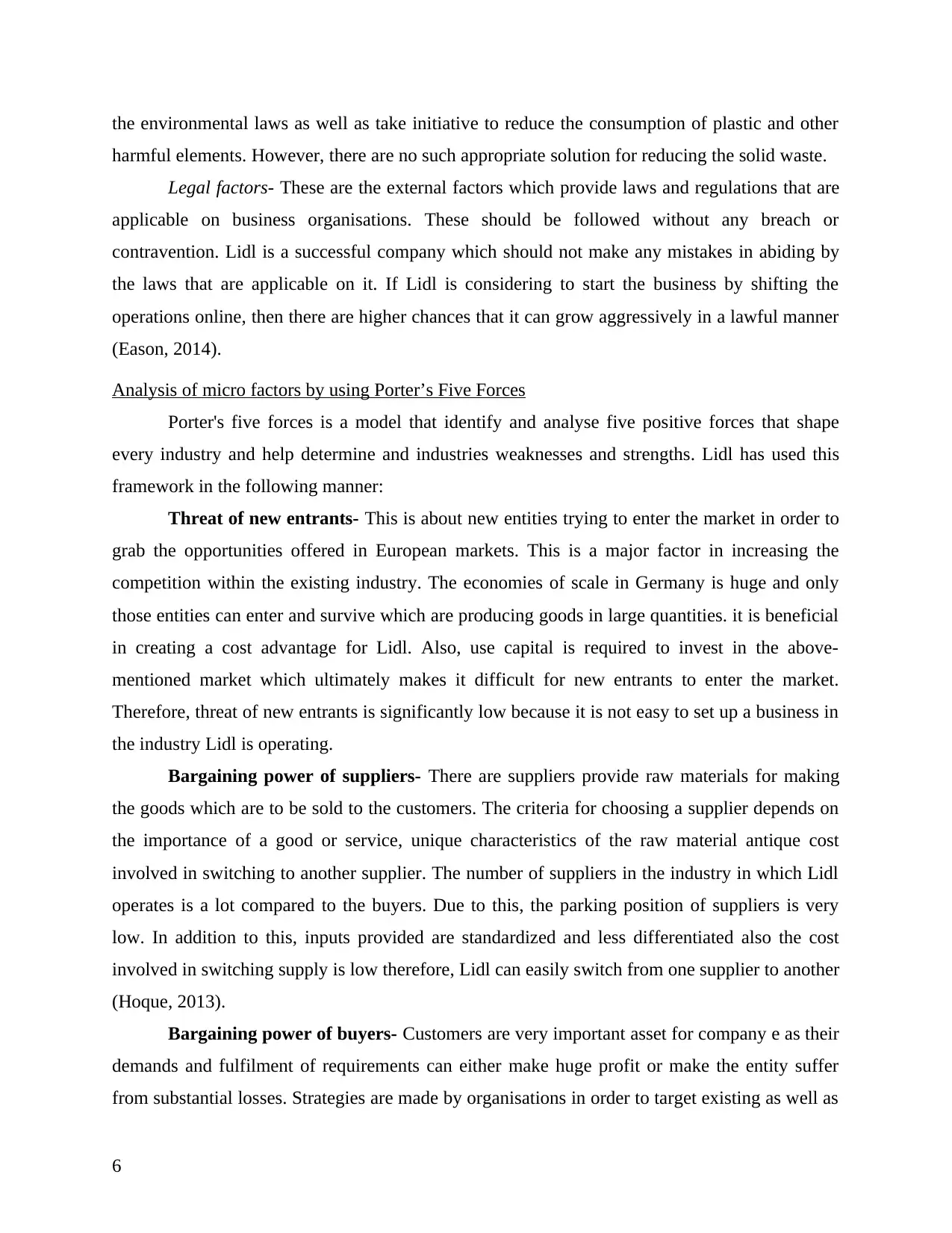
the environmental laws as well as take initiative to reduce the consumption of plastic and other
harmful elements. However, there are no such appropriate solution for reducing the solid waste.
Legal factors- These are the external factors which provide laws and regulations that are
applicable on business organisations. These should be followed without any breach or
contravention. Lidl is a successful company which should not make any mistakes in abiding by
the laws that are applicable on it. If Lidl is considering to start the business by shifting the
operations online, then there are higher chances that it can grow aggressively in a lawful manner
(Eason, 2014).
Analysis of micro factors by using Porter’s Five Forces
Porter's five forces is a model that identify and analyse five positive forces that shape
every industry and help determine and industries weaknesses and strengths. Lidl has used this
framework in the following manner:
Threat of new entrants- This is about new entities trying to enter the market in order to
grab the opportunities offered in European markets. This is a major factor in increasing the
competition within the existing industry. The economies of scale in Germany is huge and only
those entities can enter and survive which are producing goods in large quantities. it is beneficial
in creating a cost advantage for Lidl. Also, use capital is required to invest in the above-
mentioned market which ultimately makes it difficult for new entrants to enter the market.
Therefore, threat of new entrants is significantly low because it is not easy to set up a business in
the industry Lidl is operating.
Bargaining power of suppliers- There are suppliers provide raw materials for making
the goods which are to be sold to the customers. The criteria for choosing a supplier depends on
the importance of a good or service, unique characteristics of the raw material antique cost
involved in switching to another supplier. The number of suppliers in the industry in which Lidl
operates is a lot compared to the buyers. Due to this, the parking position of suppliers is very
low. In addition to this, inputs provided are standardized and less differentiated also the cost
involved in switching supply is low therefore, Lidl can easily switch from one supplier to another
(Hoque, 2013).
Bargaining power of buyers- Customers are very important asset for company e as their
demands and fulfilment of requirements can either make huge profit or make the entity suffer
from substantial losses. Strategies are made by organisations in order to target existing as well as
6
harmful elements. However, there are no such appropriate solution for reducing the solid waste.
Legal factors- These are the external factors which provide laws and regulations that are
applicable on business organisations. These should be followed without any breach or
contravention. Lidl is a successful company which should not make any mistakes in abiding by
the laws that are applicable on it. If Lidl is considering to start the business by shifting the
operations online, then there are higher chances that it can grow aggressively in a lawful manner
(Eason, 2014).
Analysis of micro factors by using Porter’s Five Forces
Porter's five forces is a model that identify and analyse five positive forces that shape
every industry and help determine and industries weaknesses and strengths. Lidl has used this
framework in the following manner:
Threat of new entrants- This is about new entities trying to enter the market in order to
grab the opportunities offered in European markets. This is a major factor in increasing the
competition within the existing industry. The economies of scale in Germany is huge and only
those entities can enter and survive which are producing goods in large quantities. it is beneficial
in creating a cost advantage for Lidl. Also, use capital is required to invest in the above-
mentioned market which ultimately makes it difficult for new entrants to enter the market.
Therefore, threat of new entrants is significantly low because it is not easy to set up a business in
the industry Lidl is operating.
Bargaining power of suppliers- There are suppliers provide raw materials for making
the goods which are to be sold to the customers. The criteria for choosing a supplier depends on
the importance of a good or service, unique characteristics of the raw material antique cost
involved in switching to another supplier. The number of suppliers in the industry in which Lidl
operates is a lot compared to the buyers. Due to this, the parking position of suppliers is very
low. In addition to this, inputs provided are standardized and less differentiated also the cost
involved in switching supply is low therefore, Lidl can easily switch from one supplier to another
(Hoque, 2013).
Bargaining power of buyers- Customers are very important asset for company e as their
demands and fulfilment of requirements can either make huge profit or make the entity suffer
from substantial losses. Strategies are made by organisations in order to target existing as well as
6
⊘ This is a preview!⊘
Do you want full access?
Subscribe today to unlock all pages.

Trusted by 1+ million students worldwide
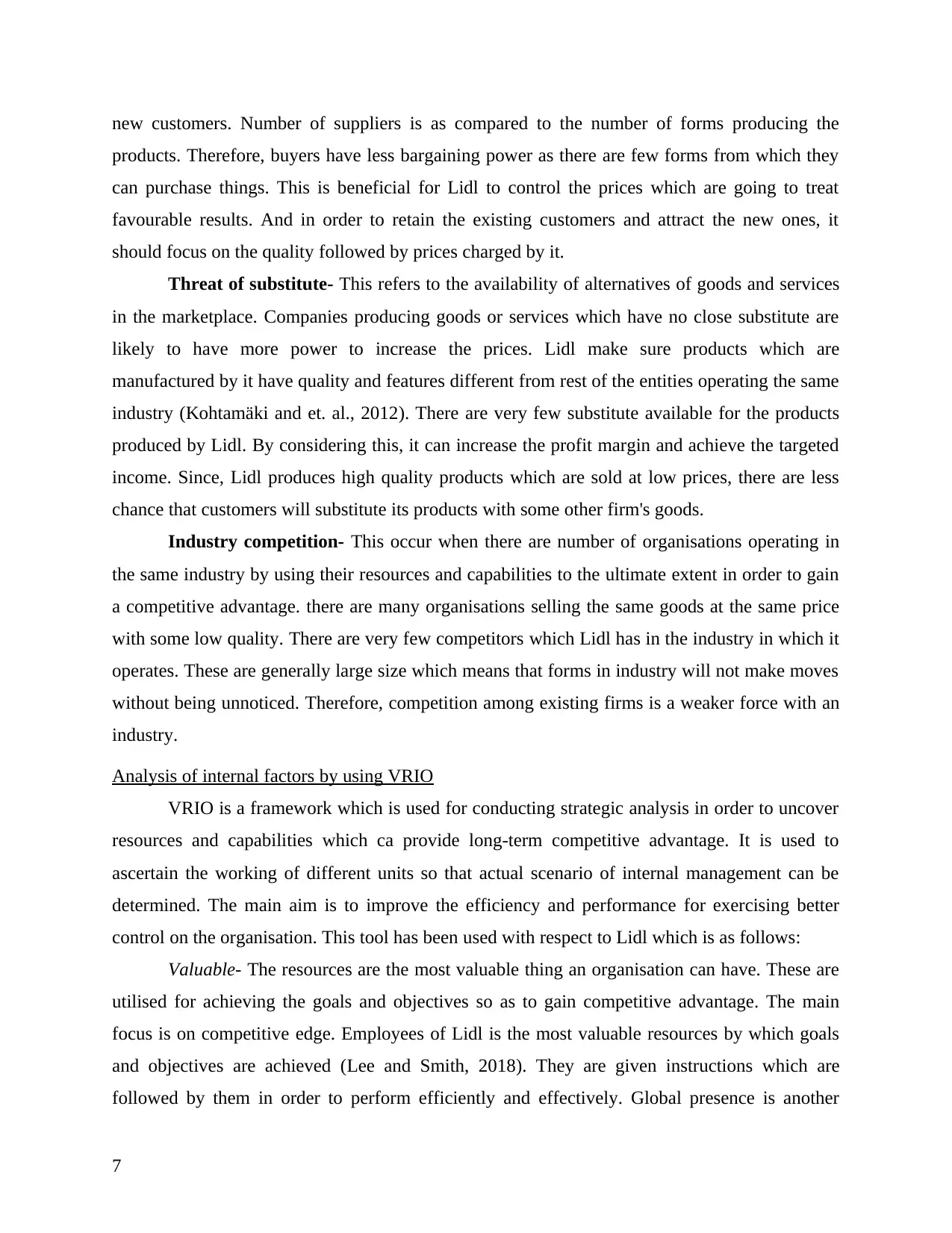
new customers. Number of suppliers is as compared to the number of forms producing the
products. Therefore, buyers have less bargaining power as there are few forms from which they
can purchase things. This is beneficial for Lidl to control the prices which are going to treat
favourable results. And in order to retain the existing customers and attract the new ones, it
should focus on the quality followed by prices charged by it.
Threat of substitute- This refers to the availability of alternatives of goods and services
in the marketplace. Companies producing goods or services which have no close substitute are
likely to have more power to increase the prices. Lidl make sure products which are
manufactured by it have quality and features different from rest of the entities operating the same
industry (Kohtamäki and et. al., 2012). There are very few substitute available for the products
produced by Lidl. By considering this, it can increase the profit margin and achieve the targeted
income. Since, Lidl produces high quality products which are sold at low prices, there are less
chance that customers will substitute its products with some other firm's goods.
Industry competition- This occur when there are number of organisations operating in
the same industry by using their resources and capabilities to the ultimate extent in order to gain
a competitive advantage. there are many organisations selling the same goods at the same price
with some low quality. There are very few competitors which Lidl has in the industry in which it
operates. These are generally large size which means that forms in industry will not make moves
without being unnoticed. Therefore, competition among existing firms is a weaker force with an
industry.
Analysis of internal factors by using VRIO
VRIO is a framework which is used for conducting strategic analysis in order to uncover
resources and capabilities which ca provide long-term competitive advantage. It is used to
ascertain the working of different units so that actual scenario of internal management can be
determined. The main aim is to improve the efficiency and performance for exercising better
control on the organisation. This tool has been used with respect to Lidl which is as follows:
Valuable- The resources are the most valuable thing an organisation can have. These are
utilised for achieving the goals and objectives so as to gain competitive advantage. The main
focus is on competitive edge. Employees of Lidl is the most valuable resources by which goals
and objectives are achieved (Lee and Smith, 2018). They are given instructions which are
followed by them in order to perform efficiently and effectively. Global presence is another
7
products. Therefore, buyers have less bargaining power as there are few forms from which they
can purchase things. This is beneficial for Lidl to control the prices which are going to treat
favourable results. And in order to retain the existing customers and attract the new ones, it
should focus on the quality followed by prices charged by it.
Threat of substitute- This refers to the availability of alternatives of goods and services
in the marketplace. Companies producing goods or services which have no close substitute are
likely to have more power to increase the prices. Lidl make sure products which are
manufactured by it have quality and features different from rest of the entities operating the same
industry (Kohtamäki and et. al., 2012). There are very few substitute available for the products
produced by Lidl. By considering this, it can increase the profit margin and achieve the targeted
income. Since, Lidl produces high quality products which are sold at low prices, there are less
chance that customers will substitute its products with some other firm's goods.
Industry competition- This occur when there are number of organisations operating in
the same industry by using their resources and capabilities to the ultimate extent in order to gain
a competitive advantage. there are many organisations selling the same goods at the same price
with some low quality. There are very few competitors which Lidl has in the industry in which it
operates. These are generally large size which means that forms in industry will not make moves
without being unnoticed. Therefore, competition among existing firms is a weaker force with an
industry.
Analysis of internal factors by using VRIO
VRIO is a framework which is used for conducting strategic analysis in order to uncover
resources and capabilities which ca provide long-term competitive advantage. It is used to
ascertain the working of different units so that actual scenario of internal management can be
determined. The main aim is to improve the efficiency and performance for exercising better
control on the organisation. This tool has been used with respect to Lidl which is as follows:
Valuable- The resources are the most valuable thing an organisation can have. These are
utilised for achieving the goals and objectives so as to gain competitive advantage. The main
focus is on competitive edge. Employees of Lidl is the most valuable resources by which goals
and objectives are achieved (Lee and Smith, 2018). They are given instructions which are
followed by them in order to perform efficiently and effectively. Global presence is another
7
Paraphrase This Document
Need a fresh take? Get an instant paraphrase of this document with our AI Paraphraser
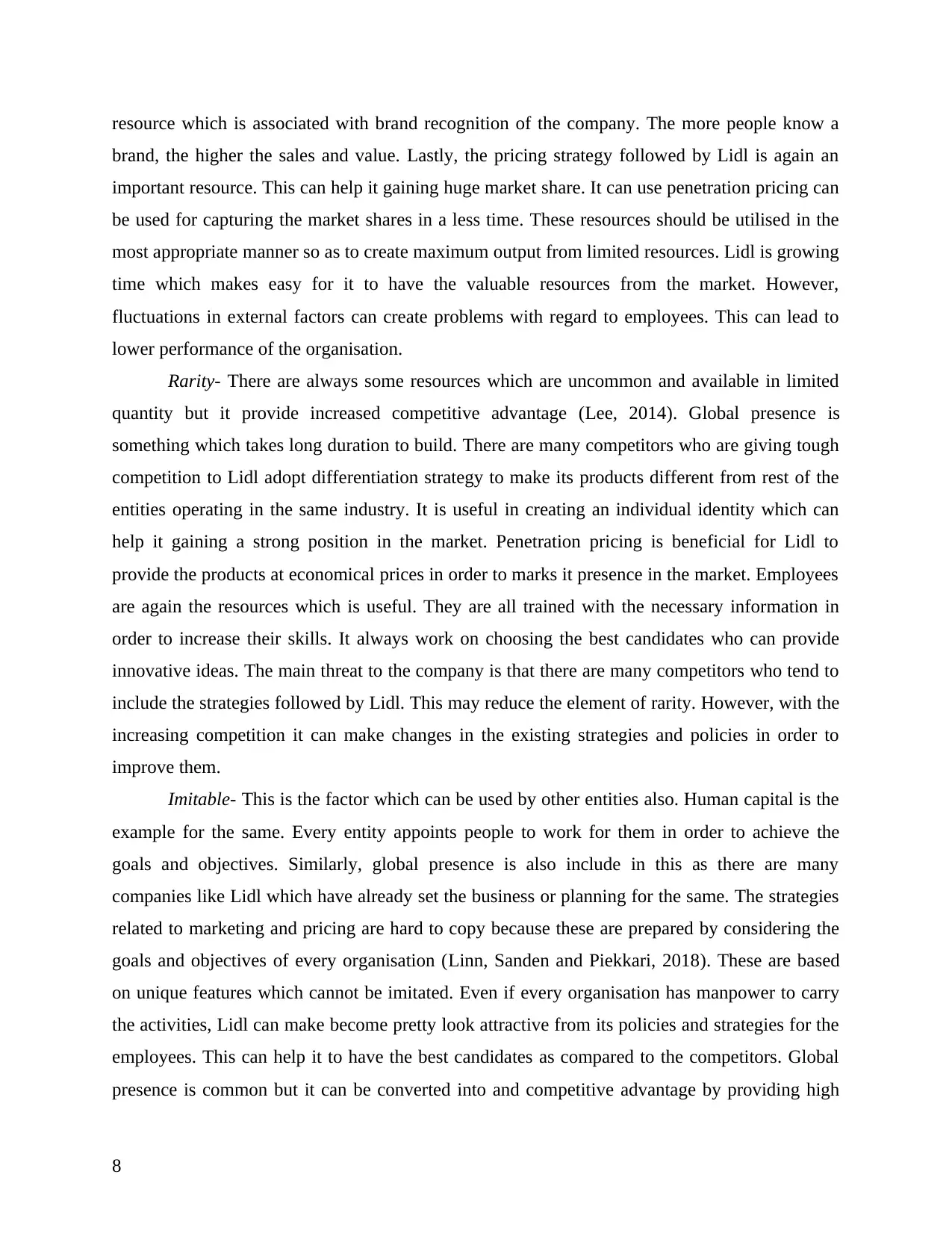
resource which is associated with brand recognition of the company. The more people know a
brand, the higher the sales and value. Lastly, the pricing strategy followed by Lidl is again an
important resource. This can help it gaining huge market share. It can use penetration pricing can
be used for capturing the market shares in a less time. These resources should be utilised in the
most appropriate manner so as to create maximum output from limited resources. Lidl is growing
time which makes easy for it to have the valuable resources from the market. However,
fluctuations in external factors can create problems with regard to employees. This can lead to
lower performance of the organisation.
Rarity- There are always some resources which are uncommon and available in limited
quantity but it provide increased competitive advantage (Lee, 2014). Global presence is
something which takes long duration to build. There are many competitors who are giving tough
competition to Lidl adopt differentiation strategy to make its products different from rest of the
entities operating in the same industry. It is useful in creating an individual identity which can
help it gaining a strong position in the market. Penetration pricing is beneficial for Lidl to
provide the products at economical prices in order to marks it presence in the market. Employees
are again the resources which is useful. They are all trained with the necessary information in
order to increase their skills. It always work on choosing the best candidates who can provide
innovative ideas. The main threat to the company is that there are many competitors who tend to
include the strategies followed by Lidl. This may reduce the element of rarity. However, with the
increasing competition it can make changes in the existing strategies and policies in order to
improve them.
Imitable- This is the factor which can be used by other entities also. Human capital is the
example for the same. Every entity appoints people to work for them in order to achieve the
goals and objectives. Similarly, global presence is also include in this as there are many
companies like Lidl which have already set the business or planning for the same. The strategies
related to marketing and pricing are hard to copy because these are prepared by considering the
goals and objectives of every organisation (Linn, Sanden and Piekkari, 2018). These are based
on unique features which cannot be imitated. Even if every organisation has manpower to carry
the activities, Lidl can make become pretty look attractive from its policies and strategies for the
employees. This can help it to have the best candidates as compared to the competitors. Global
presence is common but it can be converted into and competitive advantage by providing high
8
brand, the higher the sales and value. Lastly, the pricing strategy followed by Lidl is again an
important resource. This can help it gaining huge market share. It can use penetration pricing can
be used for capturing the market shares in a less time. These resources should be utilised in the
most appropriate manner so as to create maximum output from limited resources. Lidl is growing
time which makes easy for it to have the valuable resources from the market. However,
fluctuations in external factors can create problems with regard to employees. This can lead to
lower performance of the organisation.
Rarity- There are always some resources which are uncommon and available in limited
quantity but it provide increased competitive advantage (Lee, 2014). Global presence is
something which takes long duration to build. There are many competitors who are giving tough
competition to Lidl adopt differentiation strategy to make its products different from rest of the
entities operating in the same industry. It is useful in creating an individual identity which can
help it gaining a strong position in the market. Penetration pricing is beneficial for Lidl to
provide the products at economical prices in order to marks it presence in the market. Employees
are again the resources which is useful. They are all trained with the necessary information in
order to increase their skills. It always work on choosing the best candidates who can provide
innovative ideas. The main threat to the company is that there are many competitors who tend to
include the strategies followed by Lidl. This may reduce the element of rarity. However, with the
increasing competition it can make changes in the existing strategies and policies in order to
improve them.
Imitable- This is the factor which can be used by other entities also. Human capital is the
example for the same. Every entity appoints people to work for them in order to achieve the
goals and objectives. Similarly, global presence is also include in this as there are many
companies like Lidl which have already set the business or planning for the same. The strategies
related to marketing and pricing are hard to copy because these are prepared by considering the
goals and objectives of every organisation (Linn, Sanden and Piekkari, 2018). These are based
on unique features which cannot be imitated. Even if every organisation has manpower to carry
the activities, Lidl can make become pretty look attractive from its policies and strategies for the
employees. This can help it to have the best candidates as compared to the competitors. Global
presence is common but it can be converted into and competitive advantage by providing high
8
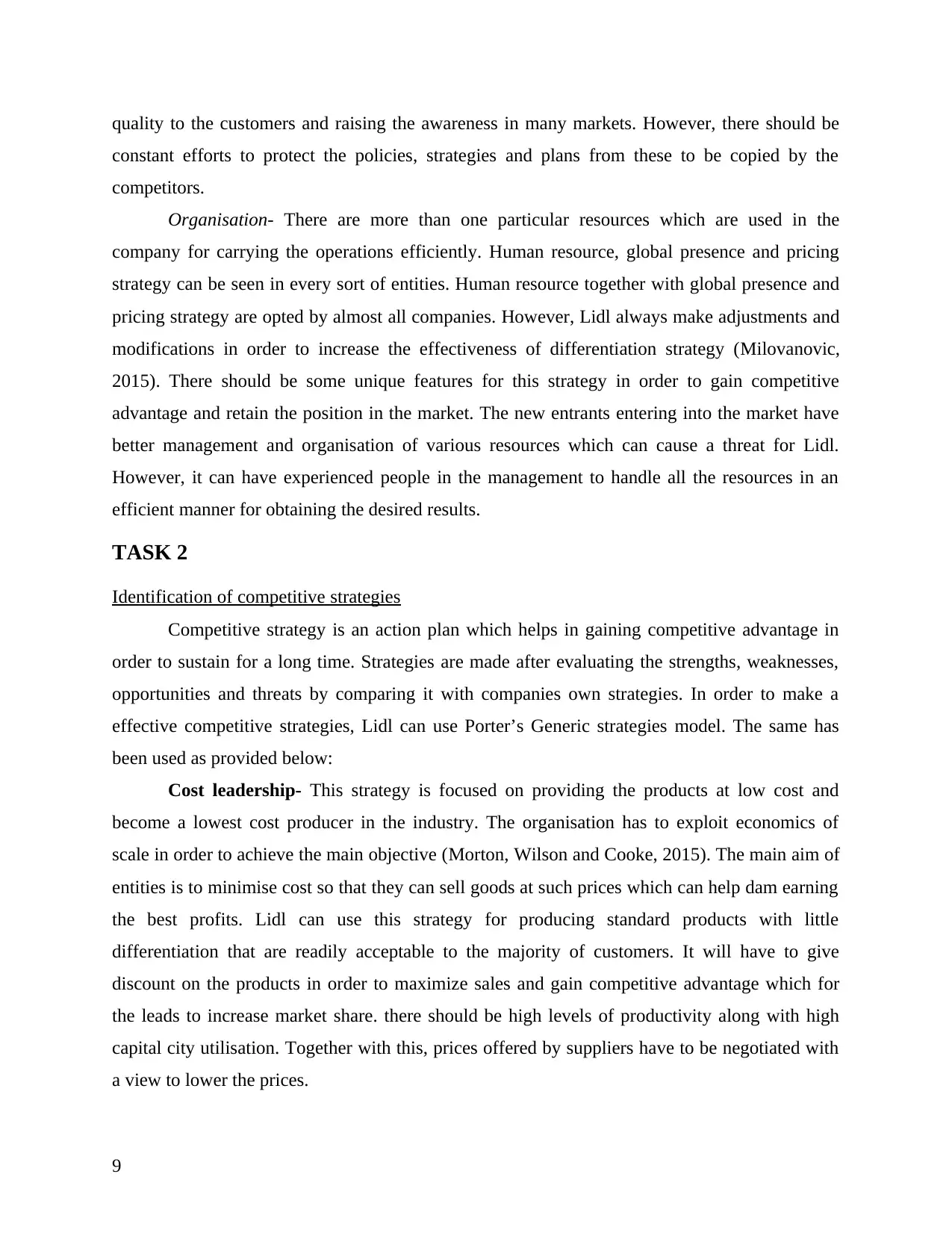
quality to the customers and raising the awareness in many markets. However, there should be
constant efforts to protect the policies, strategies and plans from these to be copied by the
competitors.
Organisation- There are more than one particular resources which are used in the
company for carrying the operations efficiently. Human resource, global presence and pricing
strategy can be seen in every sort of entities. Human resource together with global presence and
pricing strategy are opted by almost all companies. However, Lidl always make adjustments and
modifications in order to increase the effectiveness of differentiation strategy (Milovanovic,
2015). There should be some unique features for this strategy in order to gain competitive
advantage and retain the position in the market. The new entrants entering into the market have
better management and organisation of various resources which can cause a threat for Lidl.
However, it can have experienced people in the management to handle all the resources in an
efficient manner for obtaining the desired results.
TASK 2
Identification of competitive strategies
Competitive strategy is an action plan which helps in gaining competitive advantage in
order to sustain for a long time. Strategies are made after evaluating the strengths, weaknesses,
opportunities and threats by comparing it with companies own strategies. In order to make a
effective competitive strategies, Lidl can use Porter’s Generic strategies model. The same has
been used as provided below:
Cost leadership- This strategy is focused on providing the products at low cost and
become a lowest cost producer in the industry. The organisation has to exploit economics of
scale in order to achieve the main objective (Morton, Wilson and Cooke, 2015). The main aim of
entities is to minimise cost so that they can sell goods at such prices which can help dam earning
the best profits. Lidl can use this strategy for producing standard products with little
differentiation that are readily acceptable to the majority of customers. It will have to give
discount on the products in order to maximize sales and gain competitive advantage which for
the leads to increase market share. there should be high levels of productivity along with high
capital city utilisation. Together with this, prices offered by suppliers have to be negotiated with
a view to lower the prices.
9
constant efforts to protect the policies, strategies and plans from these to be copied by the
competitors.
Organisation- There are more than one particular resources which are used in the
company for carrying the operations efficiently. Human resource, global presence and pricing
strategy can be seen in every sort of entities. Human resource together with global presence and
pricing strategy are opted by almost all companies. However, Lidl always make adjustments and
modifications in order to increase the effectiveness of differentiation strategy (Milovanovic,
2015). There should be some unique features for this strategy in order to gain competitive
advantage and retain the position in the market. The new entrants entering into the market have
better management and organisation of various resources which can cause a threat for Lidl.
However, it can have experienced people in the management to handle all the resources in an
efficient manner for obtaining the desired results.
TASK 2
Identification of competitive strategies
Competitive strategy is an action plan which helps in gaining competitive advantage in
order to sustain for a long time. Strategies are made after evaluating the strengths, weaknesses,
opportunities and threats by comparing it with companies own strategies. In order to make a
effective competitive strategies, Lidl can use Porter’s Generic strategies model. The same has
been used as provided below:
Cost leadership- This strategy is focused on providing the products at low cost and
become a lowest cost producer in the industry. The organisation has to exploit economics of
scale in order to achieve the main objective (Morton, Wilson and Cooke, 2015). The main aim of
entities is to minimise cost so that they can sell goods at such prices which can help dam earning
the best profits. Lidl can use this strategy for producing standard products with little
differentiation that are readily acceptable to the majority of customers. It will have to give
discount on the products in order to maximize sales and gain competitive advantage which for
the leads to increase market share. there should be high levels of productivity along with high
capital city utilisation. Together with this, prices offered by suppliers have to be negotiated with
a view to lower the prices.
9
⊘ This is a preview!⊘
Do you want full access?
Subscribe today to unlock all pages.

Trusted by 1+ million students worldwide
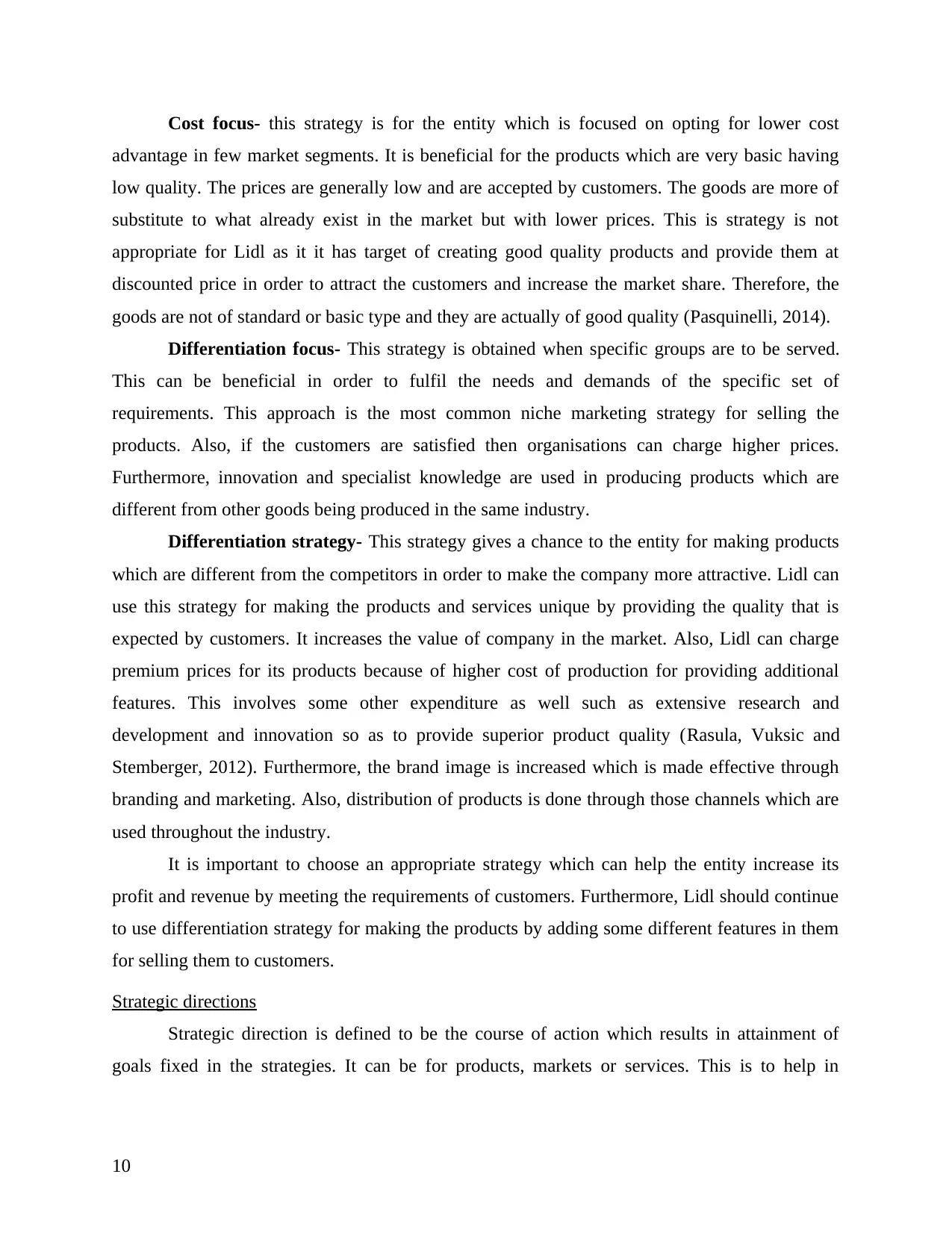
Cost focus- this strategy is for the entity which is focused on opting for lower cost
advantage in few market segments. It is beneficial for the products which are very basic having
low quality. The prices are generally low and are accepted by customers. The goods are more of
substitute to what already exist in the market but with lower prices. This is strategy is not
appropriate for Lidl as it it has target of creating good quality products and provide them at
discounted price in order to attract the customers and increase the market share. Therefore, the
goods are not of standard or basic type and they are actually of good quality (Pasquinelli, 2014).
Differentiation focus- This strategy is obtained when specific groups are to be served.
This can be beneficial in order to fulfil the needs and demands of the specific set of
requirements. This approach is the most common niche marketing strategy for selling the
products. Also, if the customers are satisfied then organisations can charge higher prices.
Furthermore, innovation and specialist knowledge are used in producing products which are
different from other goods being produced in the same industry.
Differentiation strategy- This strategy gives a chance to the entity for making products
which are different from the competitors in order to make the company more attractive. Lidl can
use this strategy for making the products and services unique by providing the quality that is
expected by customers. It increases the value of company in the market. Also, Lidl can charge
premium prices for its products because of higher cost of production for providing additional
features. This involves some other expenditure as well such as extensive research and
development and innovation so as to provide superior product quality (Rasula, Vuksic and
Stemberger, 2012). Furthermore, the brand image is increased which is made effective through
branding and marketing. Also, distribution of products is done through those channels which are
used throughout the industry.
It is important to choose an appropriate strategy which can help the entity increase its
profit and revenue by meeting the requirements of customers. Furthermore, Lidl should continue
to use differentiation strategy for making the products by adding some different features in them
for selling them to customers.
Strategic directions
Strategic direction is defined to be the course of action which results in attainment of
goals fixed in the strategies. It can be for products, markets or services. This is to help in
10
advantage in few market segments. It is beneficial for the products which are very basic having
low quality. The prices are generally low and are accepted by customers. The goods are more of
substitute to what already exist in the market but with lower prices. This is strategy is not
appropriate for Lidl as it it has target of creating good quality products and provide them at
discounted price in order to attract the customers and increase the market share. Therefore, the
goods are not of standard or basic type and they are actually of good quality (Pasquinelli, 2014).
Differentiation focus- This strategy is obtained when specific groups are to be served.
This can be beneficial in order to fulfil the needs and demands of the specific set of
requirements. This approach is the most common niche marketing strategy for selling the
products. Also, if the customers are satisfied then organisations can charge higher prices.
Furthermore, innovation and specialist knowledge are used in producing products which are
different from other goods being produced in the same industry.
Differentiation strategy- This strategy gives a chance to the entity for making products
which are different from the competitors in order to make the company more attractive. Lidl can
use this strategy for making the products and services unique by providing the quality that is
expected by customers. It increases the value of company in the market. Also, Lidl can charge
premium prices for its products because of higher cost of production for providing additional
features. This involves some other expenditure as well such as extensive research and
development and innovation so as to provide superior product quality (Rasula, Vuksic and
Stemberger, 2012). Furthermore, the brand image is increased which is made effective through
branding and marketing. Also, distribution of products is done through those channels which are
used throughout the industry.
It is important to choose an appropriate strategy which can help the entity increase its
profit and revenue by meeting the requirements of customers. Furthermore, Lidl should continue
to use differentiation strategy for making the products by adding some different features in them
for selling them to customers.
Strategic directions
Strategic direction is defined to be the course of action which results in attainment of
goals fixed in the strategies. It can be for products, markets or services. This is to help in
10
Paraphrase This Document
Need a fresh take? Get an instant paraphrase of this document with our AI Paraphraser
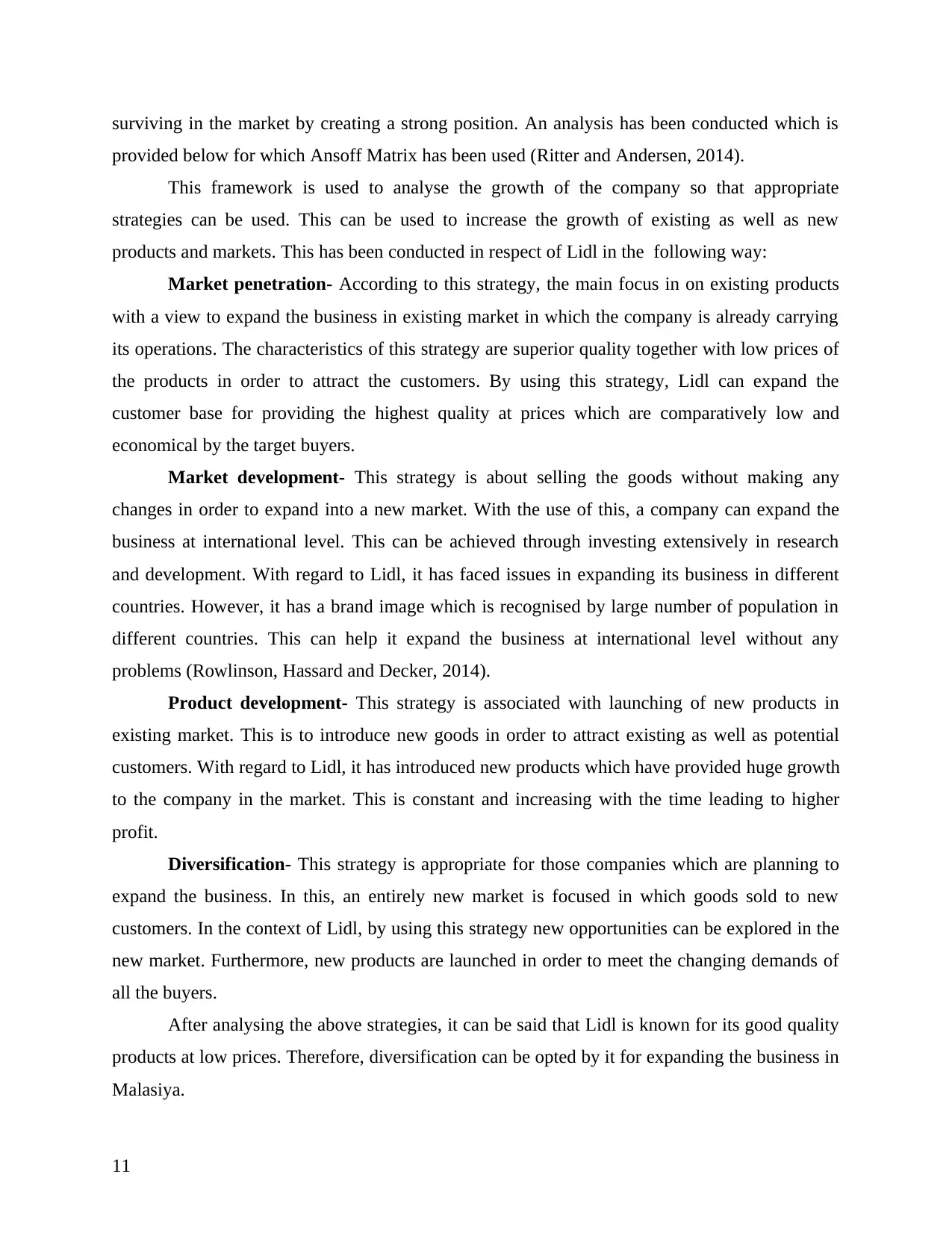
surviving in the market by creating a strong position. An analysis has been conducted which is
provided below for which Ansoff Matrix has been used (Ritter and Andersen, 2014).
This framework is used to analyse the growth of the company so that appropriate
strategies can be used. This can be used to increase the growth of existing as well as new
products and markets. This has been conducted in respect of Lidl in the following way:
Market penetration- According to this strategy, the main focus in on existing products
with a view to expand the business in existing market in which the company is already carrying
its operations. The characteristics of this strategy are superior quality together with low prices of
the products in order to attract the customers. By using this strategy, Lidl can expand the
customer base for providing the highest quality at prices which are comparatively low and
economical by the target buyers.
Market development- This strategy is about selling the goods without making any
changes in order to expand into a new market. With the use of this, a company can expand the
business at international level. This can be achieved through investing extensively in research
and development. With regard to Lidl, it has faced issues in expanding its business in different
countries. However, it has a brand image which is recognised by large number of population in
different countries. This can help it expand the business at international level without any
problems (Rowlinson, Hassard and Decker, 2014).
Product development- This strategy is associated with launching of new products in
existing market. This is to introduce new goods in order to attract existing as well as potential
customers. With regard to Lidl, it has introduced new products which have provided huge growth
to the company in the market. This is constant and increasing with the time leading to higher
profit.
Diversification- This strategy is appropriate for those companies which are planning to
expand the business. In this, an entirely new market is focused in which goods sold to new
customers. In the context of Lidl, by using this strategy new opportunities can be explored in the
new market. Furthermore, new products are launched in order to meet the changing demands of
all the buyers.
After analysing the above strategies, it can be said that Lidl is known for its good quality
products at low prices. Therefore, diversification can be opted by it for expanding the business in
Malasiya.
11
provided below for which Ansoff Matrix has been used (Ritter and Andersen, 2014).
This framework is used to analyse the growth of the company so that appropriate
strategies can be used. This can be used to increase the growth of existing as well as new
products and markets. This has been conducted in respect of Lidl in the following way:
Market penetration- According to this strategy, the main focus in on existing products
with a view to expand the business in existing market in which the company is already carrying
its operations. The characteristics of this strategy are superior quality together with low prices of
the products in order to attract the customers. By using this strategy, Lidl can expand the
customer base for providing the highest quality at prices which are comparatively low and
economical by the target buyers.
Market development- This strategy is about selling the goods without making any
changes in order to expand into a new market. With the use of this, a company can expand the
business at international level. This can be achieved through investing extensively in research
and development. With regard to Lidl, it has faced issues in expanding its business in different
countries. However, it has a brand image which is recognised by large number of population in
different countries. This can help it expand the business at international level without any
problems (Rowlinson, Hassard and Decker, 2014).
Product development- This strategy is associated with launching of new products in
existing market. This is to introduce new goods in order to attract existing as well as potential
customers. With regard to Lidl, it has introduced new products which have provided huge growth
to the company in the market. This is constant and increasing with the time leading to higher
profit.
Diversification- This strategy is appropriate for those companies which are planning to
expand the business. In this, an entirely new market is focused in which goods sold to new
customers. In the context of Lidl, by using this strategy new opportunities can be explored in the
new market. Furthermore, new products are launched in order to meet the changing demands of
all the buyers.
After analysing the above strategies, it can be said that Lidl is known for its good quality
products at low prices. Therefore, diversification can be opted by it for expanding the business in
Malasiya.
11
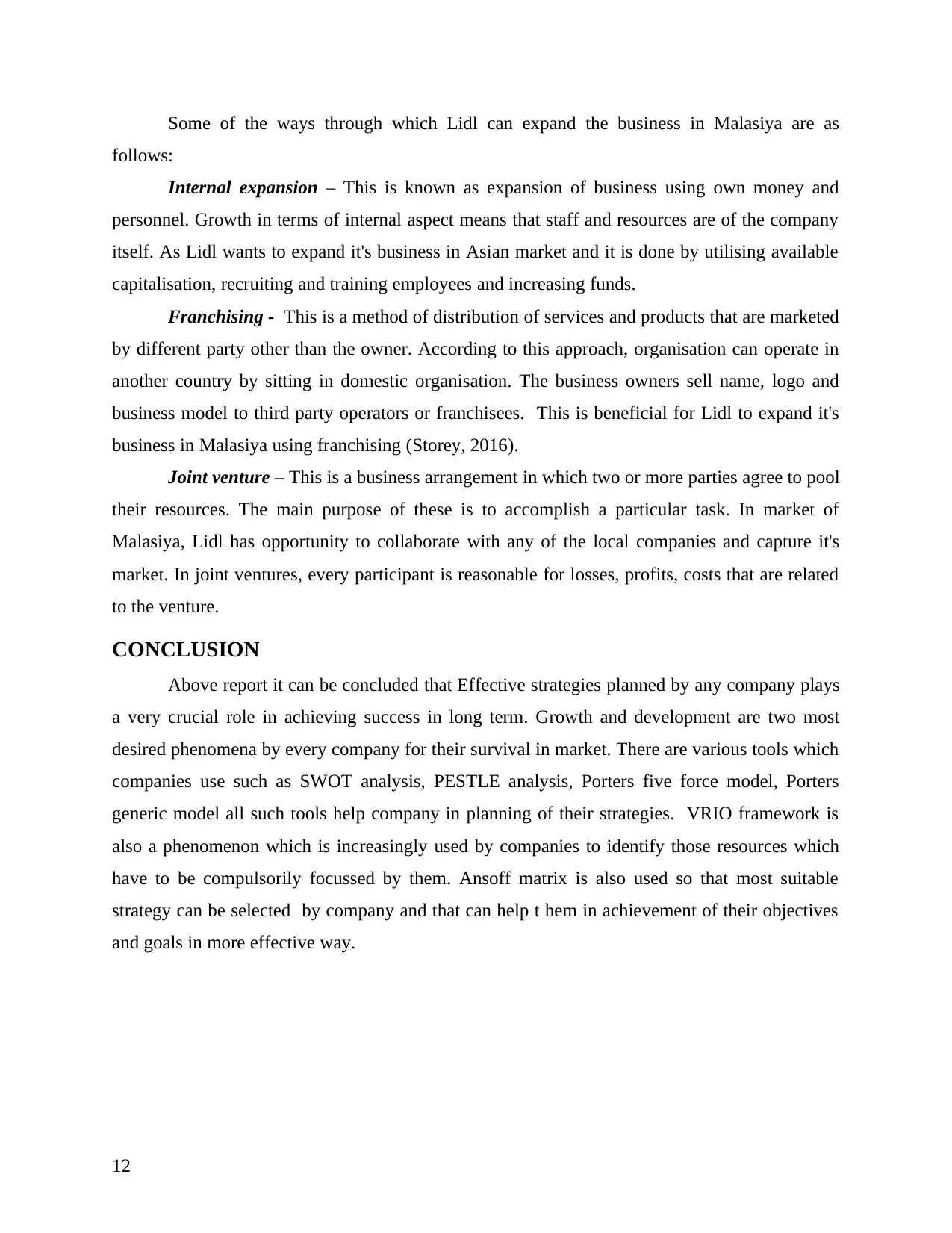
Some of the ways through which Lidl can expand the business in Malasiya are as
follows:
Internal expansion – This is known as expansion of business using own money and
personnel. Growth in terms of internal aspect means that staff and resources are of the company
itself. As Lidl wants to expand it's business in Asian market and it is done by utilising available
capitalisation, recruiting and training employees and increasing funds.
Franchising - This is a method of distribution of services and products that are marketed
by different party other than the owner. According to this approach, organisation can operate in
another country by sitting in domestic organisation. The business owners sell name, logo and
business model to third party operators or franchisees. This is beneficial for Lidl to expand it's
business in Malasiya using franchising (Storey, 2016).
Joint venture – This is a business arrangement in which two or more parties agree to pool
their resources. The main purpose of these is to accomplish a particular task. In market of
Malasiya, Lidl has opportunity to collaborate with any of the local companies and capture it's
market. In joint ventures, every participant is reasonable for losses, profits, costs that are related
to the venture.
CONCLUSION
Above report it can be concluded that Effective strategies planned by any company plays
a very crucial role in achieving success in long term. Growth and development are two most
desired phenomena by every company for their survival in market. There are various tools which
companies use such as SWOT analysis, PESTLE analysis, Porters five force model, Porters
generic model all such tools help company in planning of their strategies. VRIO framework is
also a phenomenon which is increasingly used by companies to identify those resources which
have to be compulsorily focussed by them. Ansoff matrix is also used so that most suitable
strategy can be selected by company and that can help t hem in achievement of their objectives
and goals in more effective way.
12
follows:
Internal expansion – This is known as expansion of business using own money and
personnel. Growth in terms of internal aspect means that staff and resources are of the company
itself. As Lidl wants to expand it's business in Asian market and it is done by utilising available
capitalisation, recruiting and training employees and increasing funds.
Franchising - This is a method of distribution of services and products that are marketed
by different party other than the owner. According to this approach, organisation can operate in
another country by sitting in domestic organisation. The business owners sell name, logo and
business model to third party operators or franchisees. This is beneficial for Lidl to expand it's
business in Malasiya using franchising (Storey, 2016).
Joint venture – This is a business arrangement in which two or more parties agree to pool
their resources. The main purpose of these is to accomplish a particular task. In market of
Malasiya, Lidl has opportunity to collaborate with any of the local companies and capture it's
market. In joint ventures, every participant is reasonable for losses, profits, costs that are related
to the venture.
CONCLUSION
Above report it can be concluded that Effective strategies planned by any company plays
a very crucial role in achieving success in long term. Growth and development are two most
desired phenomena by every company for their survival in market. There are various tools which
companies use such as SWOT analysis, PESTLE analysis, Porters five force model, Porters
generic model all such tools help company in planning of their strategies. VRIO framework is
also a phenomenon which is increasingly used by companies to identify those resources which
have to be compulsorily focussed by them. Ansoff matrix is also used so that most suitable
strategy can be selected by company and that can help t hem in achievement of their objectives
and goals in more effective way.
12
⊘ This is a preview!⊘
Do you want full access?
Subscribe today to unlock all pages.

Trusted by 1+ million students worldwide
1 out of 14
Related Documents
Your All-in-One AI-Powered Toolkit for Academic Success.
+13062052269
info@desklib.com
Available 24*7 on WhatsApp / Email
![[object Object]](/_next/static/media/star-bottom.7253800d.svg)
Unlock your academic potential
Copyright © 2020–2025 A2Z Services. All Rights Reserved. Developed and managed by ZUCOL.





